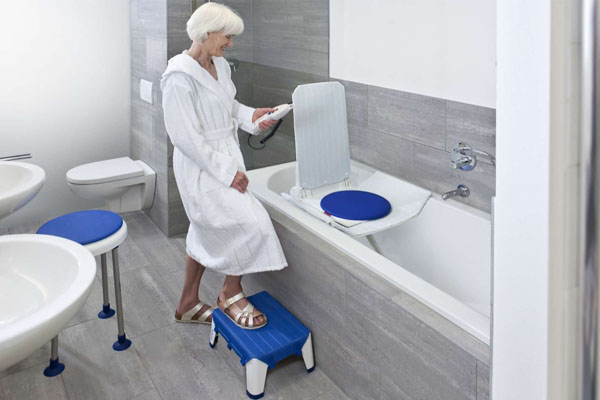Bathroom Safety Fail and Slip Prevention
14 January 2021
Most slip and fall accidents that occur in the home happen in the bathroom. So many slick, hard surfaces combined with the presence of moisture make for hazardous conditions. Therefore, when securing the home of an elder relative or loved one, special attention must be paid to the bathroom. There are also many bathroom aids for the elderly.

Start with the floor. Remove all clutter such as plants, hampers and trash baskets that might make it difficult for seniors to navigate this sometimes small and restricted area. This includes rugs, since even those with non-slip backing can present an obstacle for seniors. If you have linoleum flooring, consider replacing it with wall-to-wall carpeting or textured tile.
Elderly bathroom aids include installing grab bars strategically throughout the room, on the outside and inside of tub or shower enclosures as well as near the toilet to help provide stability and security. There are a number of more aesthetically pleasing alternatives to the traditional aluminum finish currently available, so you don’t have to sacrifice appearance in favor of safety.
Next, for bathtub slip prevention, consider replacing the tub with a handicapped-accessible walk-in shower or tub. If this isn’t possible, a good alternative is a transfer bench that straddles the edge of the tub and makes getting in and out of the shower much easier for mobility-challenged individuals. Whatever solution you choose, be sure to place a self-adhesive non-slip mat on the inside of the tub to provide more sure footing. Non slip bath mats for elderly individuals can really help to prevent falls in the bathtub.
Finally, since many seniors have trouble getting on and off the commode, consider purchasing a toilet safety frame. These frames fit over the toilet and have armrests that allow the user to lower and raise themselves easily. Another convenient and inexpensive option is a toilet riser. This is a simple seat that fits over the existing toilet seat, making it several inches taller.
With all the water, sharp edges and slippery flooring, the bathroom can be a very dangerous place… especially for an elderly person.
Here’s a list of 7 things you should check in your loved one’s bathroom:
- Does your elderly parent or relative often use the towel rack near the bathtub for support when climbing in or out of the tub?
- Is the shower floor or bathtub noticeably slippery, even when dry?
- Do puddles of water appear on the floor after the bathtub or shower is used?
- Are towels, soap and shampoo difficult to reach?
- Does your loved one have difficulty sitting on or rising from the toilet?
- Is the path from the bedroom to the bathroom dark or hazardous?
- Is there a rug that tends to bunch up or could potentially cause a fall?
If you answered “yes” to one or more of these questions, it is time to safety-proof your loved one’s bathroom. But don’t worry; it’s not difficult!
Bathroom safety for seniors is very crucial, but also quite simple to do.
Here are 9 tips to help your loved one avoid bathroom injuries:
- Install anchor grab bars in and around the shower, bathtub and toilet. Use solid screws; don’t just nail them into the drywall. Then, test them for strength and stability by grabbing onto them as if you were actually falling. They should not budge
- Place non-skid mats and decals on the floor of the shower stall or bathtub, as well as on the surrounding floor
- Consider placing a stool or shower chair in the shower stall. A walk-in bath may be a good option, as well
- Make sure there are places to sit and take care of toiletries, such as brushing the teeth, if your loved one tires quickly
- Make sure the towels, soap and shampoo are within easy reach from the shower or tub
- Put nightlights or motion lighting on the path from your loved one’s bedroom to the bathroom, and even in the bathroom itself
- The toilet can be modified with a raised toilet seat. A higher rising toilet can also be installed
- Make sure taps are easy to turn and clearly marked “hot” and “cold.”
- Remove any dangerous rugs that could cause slips and trips; replace them with anti-slip mats (especially around the shower or bathtub) or textured tile flooring
When it comes to bathroom safety, you and your loved one cannot afford to cut any corners.
A safe bathroom will give you the peace of mind that your loved one can go to the bathroom or bathe with a significantly lowered risk of injury.
Residential Care Guide
Eligibility and AssessmentNew Aged Care Homes
Residential Care Financials
- Residential Care Fee Categories
- Current Fees and Charges
- Basic Daily Care Fee
- Means Tested Care Fee
- What is a RAD, DAP, MPIR?
- Current and Historical MPIR's
- Refundable Accommodation Deposit (RAD)
- Daily Accommodation Payment (DAP)
- Maximum Permissible Interest Rate (MPIR)
- Additional Service Fee (ASF)
Centrelink Form SA485 Explained
Centrelink Form SA457 Explained
Residential Care Agreement
Age Pension Current Rates